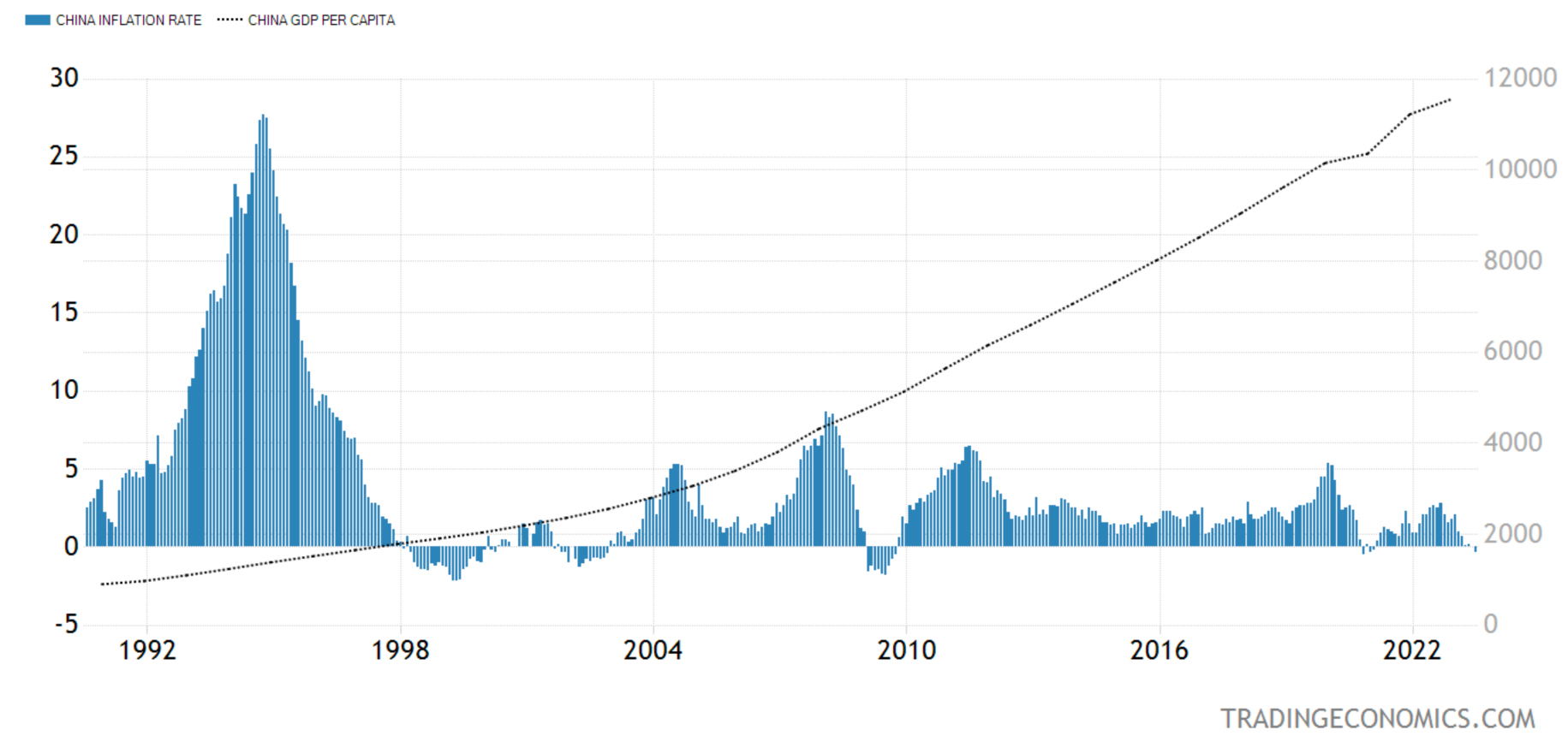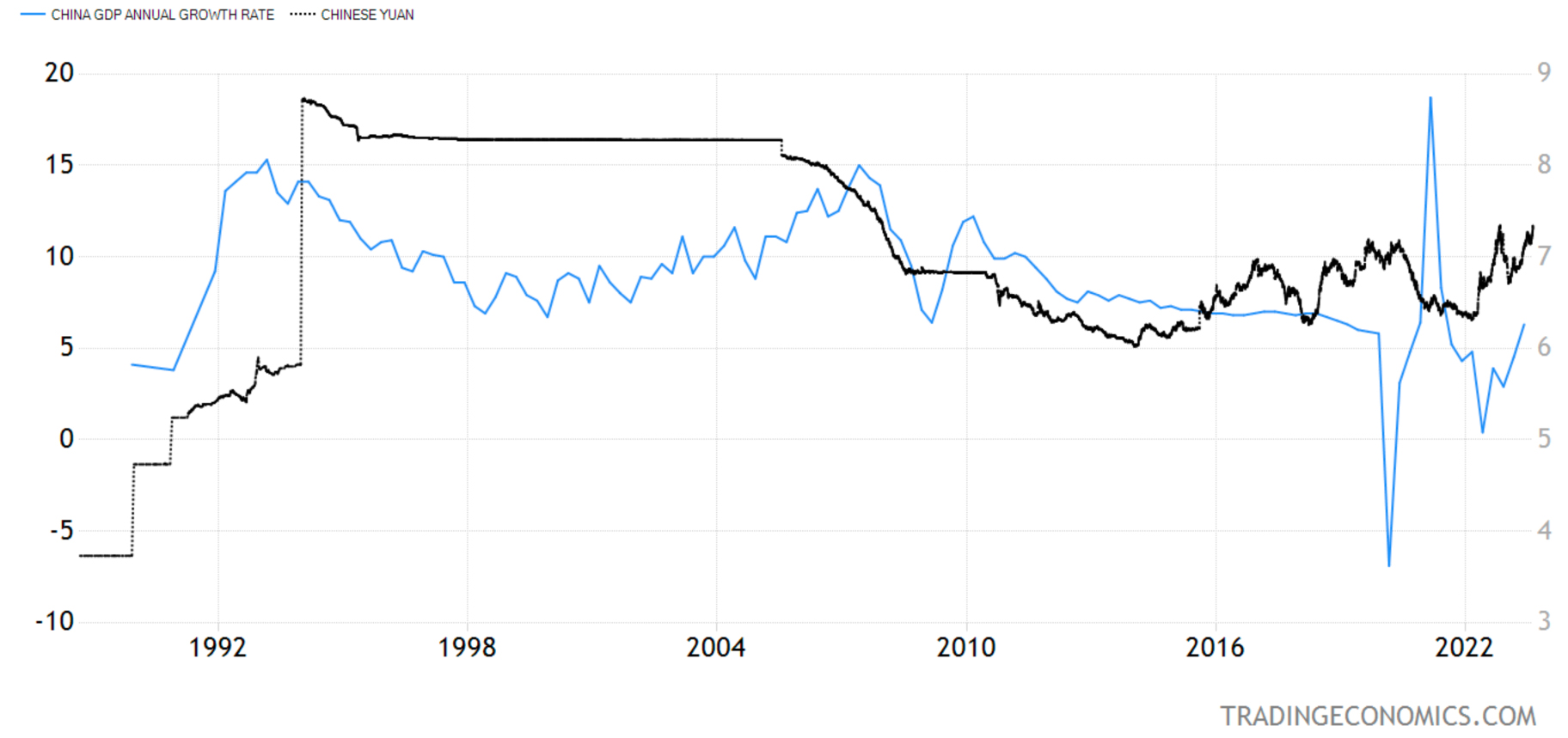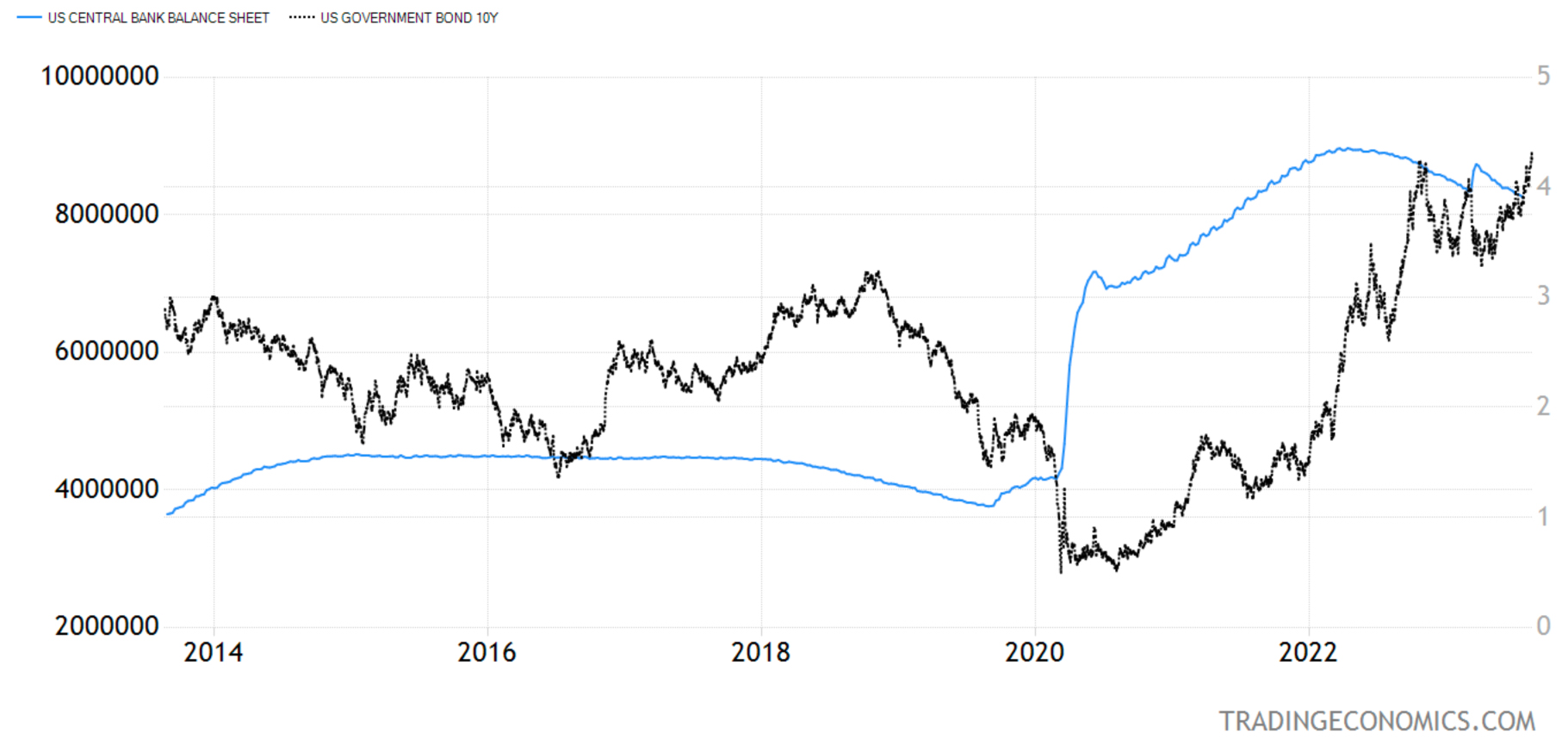by Ivan Martchev
August 22, 2023
We have seen Chinese real estate and wealth management issues in years past and they never came to a hard landing, but the mere fact that it has not happened yet does not mean it won’t ultimately happen. It is those failing real estate developers and issuers of wealth management products that cannot pay their clients of late that are raising alarms in the institutional and retail investor communities.
China has once again slipped into deflation. The latest year-over-year inflation rate was -0.3%.

Graphs are for illustrative and discussion purposes only. Please read important disclosures at the end of this commentary.
As this chart shows, China has slipped into deflation before, most recently after the draconian COVID lock-downs in 2020, and also right after the Wall Street crash in 2008-09, and right after the dot.com crash in 2001, and during the Asian Crisis of 1997-1998. None of these previous deflationary periods came during good times for the global or Asian economy, but the fact that the global and regional economies are holding up right now and China has still entered into deflation may indicate that this may be a sign of a much bigger domestic economic problem than Beijing will ever admit.
The reason for the massive Chinese devaluation of the yuan in 1994 – to the tune of 33% (see the spike in inflation rates, above) – was a nasty recession in 1993 that was never officially acknowledged by the Chinese authorities and their doctored statistics, but it showed up in bank loan loss provisions that they forgot to doctor, according to some experts on Asia. Officially, there was no recession, but the horrific devaluation ultimately was a big contributing factor to the onset of the Asian Crisis in 1997-1998, which was nasty for their local economic partners. I would not put it past the Chinese to try to do the same thing again if their back is to the wall and their banking system is under stress and their economy needs a jolt.
The Chinese have a new Premier – a President Xi loyalist who will do as he is told – so I would not put that much weight in the promises of the previous Premier who used to often say that they would never use the currency to jump-start the Chinese economy. I think they will – if they feel they have no other choice.

Graphs are for illustrative and discussion purposes only. Please read important disclosures at the end of this commentary.
A Chinese devaluation would be like a deflationary tsunami for the global economy. A Chinese devaluation would be particularly hard on export-driven Asian economies, and it is unknowable for now if a Second Asian Financial Crisis may be in the cards, despite the many reforms made since the last one.
A teetering Chinese real estate market is not good for domestic demand as many Chinese use a reported 60 million empty apartments as their savings accounts. Any further weakening of the real estate market should have a notable effect on Chinese economic growth.
What the Chinese have done with their unique system of state sponsored capitalism under the leadership of the CCP is to try to even out normal economic cycles via draconian intervention in the economy and thus avoid recessions. Personally, I do not believe economic cycles can be ironed out with lending quotas and state control of the financial system. Lending quotas create bad loans and ultimately create a bigger problem later on. I am watching with great interest how the Chinese situation is developing as they are overdue for a reckoning. They have postponed quite a few recessions with their interventions since 1994.
Here Comes Jackson Hole
Fed Chair Jerome Powell rattled both stock and bond markets last year with his Jackson Hole speech, and I doubt he will do the same this year, as we have a much more benign inflation outlook this year, and the Fed tightening cycle is close to completion. Still, you never know with Jay Powell, as his FOMC press conferences have caused many whipsaws over the past year. If the market was weak when the FOMC statement came out, it would rally in the press conferences and vice versa as he elaborated on his views.

Graphs are for illustrative and discussion purposes only. Please read important disclosures at the end of this commentary.
Keep in mind that the M2 Money Supply shrank for the seventh consecutive month in June to the tune of -3.6%. The Fed is shrinking its balance sheet to the tune of $95 billion per month and the U.S. Treasury is in the midst of a $1 trillion issuance of Treasury bonds as they nearly depleted their account at the Fed, as House Speaker McCarthy negotiated the debt ceiling deal with them. That’s a lot of liquidity being sucked out of the U.S. financial system in short order, so more rate hikes at this point seem like overkill, literally.
The 10-year Treasury bond yield tagged 4.33% last week, matching its prior (October 2022) multi-year high. If the 10-year blasts past 4.33% — from a purely technical perspective, in theory – it can rise to 5.25%, but I don’t think it can make it there without causing serious economic and stock market problems.
But then, I didn’t think we would come anywhere near 4.33% in August 2023, and here we are.
All content above represents the opinion of Ivan Martchev of Navellier & Associates, Inc.
Also In This Issue
A Look Ahead by Louis Navellier
The Fed May Be “Data-Dependent,” But Some of That Data is Flawed
Income Mail by Bryan Perry
China’s Economy is at Risk of Experiencing a Japan-Like Lost Decade
Growth Mail by Gary Alexander
Decision Time: Will the 2020s Be Another Roaring ‘20s or Stagnant 70s?
Global Mail by Ivan Martchev
Questions About China Intensify
Sector Spotlight by Jason Bodner
With Europe Taking All of August Off, Why Not Close August Markets?
View Full Archive
Read Past Issues Here

Ivan Martchev
INVESTMENT STRATEGIST
Ivan Martchev is an investment strategist with Navellier. Previously, Ivan served as editorial director at InvestorPlace Media. Ivan was editor of Louis Rukeyser’s Mutual Funds and associate editor of Personal Finance. Ivan is also co-author of The Silk Road to Riches (Financial Times Press). The book provided analysis of geopolitical issues and investment strategy in natural resources and emerging markets with an emphasis on Asia. The book also correctly predicted the collapse in the U.S. real estate market, the rise of precious metals, and the resulting increased investor interest in emerging markets. Ivan’s commentaries have been published by MSNBC, The Motley Fool, MarketWatch, and others. All content of “Global Mail” represents the opinion of Ivan Martchev
Important Disclosures:
Although information in these reports has been obtained from and is based upon sources that Navellier believes to be reliable, Navellier does not guarantee its accuracy and it may be incomplete or condensed. All opinions and estimates constitute Navellier’s judgment as of the date the report was created and are subject to change without notice. These reports are for informational purposes only and are not a solicitation for the purchase or sale of a security. Any decision to purchase securities mentioned in these reports must take into account existing public information on such securities or any registered prospectus.To the extent permitted by law, neither Navellier & Associates, Inc., nor any of its affiliates, agents, or service providers assumes any liability or responsibility nor owes any duty of care for any consequences of any person acting or refraining to act in reliance on the information contained in this communication or for any decision based on it.
Past performance is no indication of future results. Investment in securities involves significant risk and has the potential for partial or complete loss of funds invested. It should not be assumed that any securities recommendations made by Navellier. in the future will be profitable or equal the performance of securities made in this report. Dividend payments are not guaranteed. The amount of a dividend payment, if any, can vary over time and issuers may reduce dividends paid on securities in the event of a recession or adverse event affecting a specific industry or issuer.
None of the stock information, data, and company information presented herein constitutes a recommendation by Navellier or a solicitation to buy or sell any securities. Any specific securities identified and described do not represent all of the securities purchased, sold, or recommended for advisory clients. The holdings identified do not represent all of the securities purchased, sold, or recommended for advisory clients and the reader should not assume that investments in the securities identified and discussed were or will be profitable.
Information presented is general information that does not take into account your individual circumstances, financial situation, or needs, nor does it present a personalized recommendation to you. Individual stocks presented may not be suitable for every investor. Investment in securities involves significant risk and has the potential for partial or complete loss of funds invested. Investment in fixed income securities has the potential for the investment return and principal value of an investment to fluctuate so that an investor’s holdings, when redeemed, may be worth less than their original cost.
One cannot invest directly in an index. Index is unmanaged and index performance does not reflect deduction of fees, expenses, or taxes. Presentation of Index data does not reflect a belief by Navellier that any stock index constitutes an investment alternative to any Navellier equity strategy or is necessarily comparable to such strategies. Among the most important differences between the Indices and Navellier strategies are that the Navellier equity strategies may (1) incur material management fees, (2) concentrate its investments in relatively few stocks, industries, or sectors, (3) have significantly greater trading activity and related costs, and (4) be significantly more or less volatile than the Indices.
ETF Risk: We may invest in exchange traded funds (“ETFs”) and some of our investment strategies are generally fully invested in ETFs. Like traditional mutual funds, ETFs charge asset-based fees, but they generally do not charge initial sales charges or redemption fees and investors typically pay only customary brokerage fees to buy and sell ETF shares. The fees and costs charged by ETFs held in client accounts will not be deducted from the compensation the client pays Navellier. ETF prices can fluctuate up or down, and a client account could lose money investing in an ETF if the prices of the securities owned by the ETF go down. ETFs are subject to additional risks:
- ETF shares may trade above or below their net asset value;
- An active trading market for an ETF’s shares may not develop or be maintained;
- The value of an ETF may be more volatile than the underlying portfolio of securities the ETF is designed to track;
- The cost of owning shares of the ETF may exceed those a client would incur by directly investing in the underlying securities; and
- Trading of an ETF’s shares may be halted if the listing exchange’s officials deem it appropriate, the shares are delisted from the exchange, or the activation of market-wide “circuit breakers” (which are tied to large decreases in stock prices) halts stock trading generally.
Grader Disclosures: Investment in equity strategies involves substantial risk and has the potential for partial or complete loss of funds invested. The sample portfolio and any accompanying charts are for informational purposes only and are not to be construed as a solicitation to buy or sell any financial instrument and should not be relied upon as the sole factor in an investment making decision. As a matter of normal and important disclosures to you, as a potential investor, please consider the following: The performance presented is not based on any actual securities trading, portfolio, or accounts, and the reported performance of the A, B, C, D, and F portfolios (collectively the “model portfolios”) should be considered mere “paper” or pro forma performance results based on Navellier’s research.
Investors evaluating any of Navellier & Associates, Inc.’s, (or its affiliates’) Investment Products must not use any information presented here, including the performance figures of the model portfolios, in their evaluation of any Navellier Investment Products. Navellier Investment Products include the firm’s mutual funds and managed accounts. The model portfolios, charts, and other information presented do not represent actual funded trades and are not actual funded portfolios. There are material differences between Navellier Investment Products’ portfolios and the model portfolios, research, and performance figures presented here. The model portfolios and the research results (1) may contain stocks or ETFs that are illiquid and difficult to trade; (2) may contain stock or ETF holdings materially different from actual funded Navellier Investment Product portfolios; (3) include the reinvestment of all dividends and other earnings, estimated trading costs, commissions, or management fees; and, (4) may not reflect prices obtained in an actual funded Navellier Investment Product portfolio. For these and other reasons, the reported performances of model portfolios do not reflect the performance results of Navellier’s actually funded and traded Investment Products. In most cases, Navellier’s Investment Products have materially lower performance results than the performances of the model portfolios presented.
This report contains statements that are, or may be considered to be, forward-looking statements. All statements that are not historical facts, including statements about our beliefs or expectations, are “forward-looking statements” within the meaning of The U.S. Private Securities Litigation Reform Act of 1995. These statements may be identified by such forward-looking terminology as “expect,” “estimate,” “plan,” “intend,” “believe,” “anticipate,” “may,” “will,” “should,” “could,” “continue,” “project,” or similar statements or variations of such terms. Our forward-looking statements are based on a series of expectations, assumptions, and projections, are not guarantees of future results or performance, and involve substantial risks and uncertainty as described in Form ADV Part 2A of our filing with the Securities and Exchange Commission (SEC), which is available at www.adviserinfo.sec.gov or by requesting a copy by emailing info@navellier.com. All of our forward-looking statements are as of the date of this report only. We can give no assurance that such expectations or forward-looking statements will prove to be correct. Actual results may differ materially. You are urged to carefully consider all such factors.
FEDERAL TAX ADVICE DISCLAIMER: As required by U.S. Treasury Regulations, you are informed that, to the extent this presentation includes any federal tax advice, the presentation is not written by Navellier to be used, and cannot be used, for the purpose of avoiding federal tax penalties. Navellier does not advise on any income tax requirements or issues. Use of any information presented by Navellier is for general information only and does not represent tax advice either express or implied. You are encouraged to seek professional tax advice for income tax questions and assistance.
IMPORTANT NEWSLETTER DISCLOSURE:The hypothetical performance results for investment newsletters that are authored or edited by Louis Navellier, including Louis Navellier’s Growth Investor, Louis Navellier’s Breakthrough Stocks, Louis Navellier’s Accelerated Profits, and Louis Navellier’s Platinum Club, are not based on any actual securities trading, portfolio, or accounts, and the newsletters’ reported hypothetical performances should be considered mere “paper” or proforma hypothetical performance results and are not actual performance of real world trades. Navellier & Associates, Inc. does not have any relation to or affiliation with the owner of these newsletters. There are material differences between Navellier Investment Products’ portfolios and the InvestorPlace Media, LLC newsletter portfolios authored by Louis Navellier. The InvestorPlace Media, LLC newsletters contain hypothetical performance that do not include transaction costs, advisory fees, or other fees a client might incur if actual investments and trades were being made by an investor. As a result, newsletter performance should not be used to evaluate Navellier Investment services which are separate and different from the newsletters. The owner of the newsletters is InvestorPlace Media, LLC and any questions concerning the newsletters, including any newsletter advertising or hypothetical Newsletter performance claims, (which are calculated solely by Investor Place Media and not Navellier) should be referred to InvestorPlace Media, LLC at (800) 718-8289.
Please note that Navellier & Associates and the Navellier Private Client Group are managed completely independent of the newsletters owned and published by InvestorPlace Media, LLC and written and edited by Louis Navellier, and investment performance of the newsletters should in no way be considered indicative of potential future investment performance for any Navellier & Associates separately managed account portfolio. Potential investors should consult with their financial advisor before investing in any Navellier Investment Product.
Navellier claims compliance with Global Investment Performance Standards (GIPS). To receive a complete list and descriptions of Navellier’s composites and/or a presentation that adheres to the GIPS standards, please contact Navellier or click here. It should not be assumed that any securities recommendations made by Navellier & Associates, Inc. in the future will be profitable or equal the performance of securities made in this report.
FactSet Disclosure: Navellier does not independently calculate the statistical information included in the attached report. The calculation and the information are provided by FactSet, a company not related to Navellier. Although information contained in the report has been obtained from FactSet and is based on sources Navellier believes to be reliable, Navellier does not guarantee its accuracy, and it may be incomplete or condensed. The report and the related FactSet sourced information are provided on an “as is” basis. The user assumes the entire risk of any use made of this information. Investors should consider the report as only a single factor in making their investment decision. The report is for informational purposes only and is not intended as an offer or solicitation for the purchase or sale of a security. FactSet sourced information is the exclusive property of FactSet. Without prior written permission of FactSet, this information may not be reproduced, disseminated or used to create any financial products. All indices are unmanaged and performance of the indices include reinvestment of dividends and interest income, unless otherwise noted, are not illustrative of any particular investment and an investment cannot be made in any index. Past performance is no guarantee of future results.
